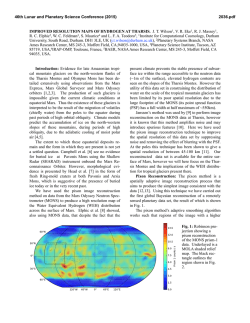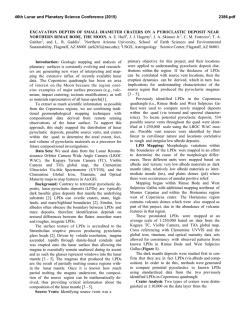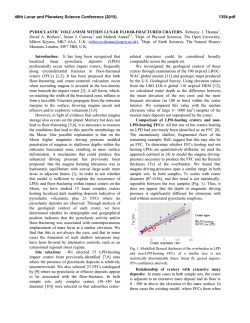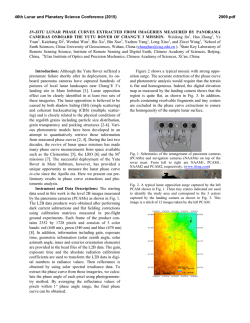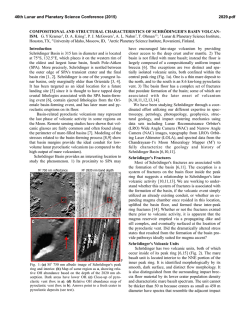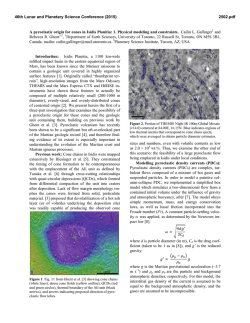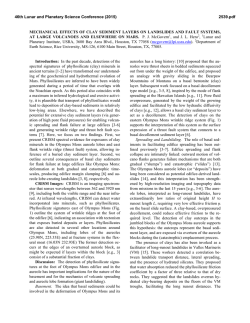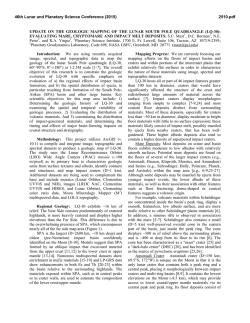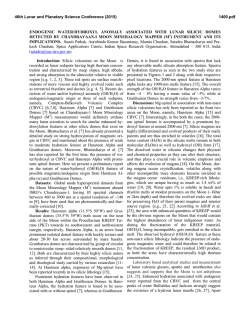
2440 - USRA
46th Lunar and Planetary Science Conference (2015) 2440.pdf SPECTRAL AND PHOTOMETRIC EXAMINATION OF PYROCLASTIC MANTLES OVER MONS RÜMKER. W.H. Farrand1, G.Y. Kramer2, L.R. Gaddis3 and G.Videen1, 1Space Science Institute, 4750 Walnut St., #205, Boulder, CO 80301, [email protected], 2Lunar and Planetary Institute, Houston, TX 77058, 3U.S. Geological Survey, Astrogeology Science Center, Flagstaff, AZ 86001. Introduction: Earth-based radar studies have detected several occurrences of low circular polarization ratio (CPR) values associated with a number of lunar domes and along some rilles [1-3]. Such a low CPR response is indicative of loose, disaggregated materials such as those in a pyroclastic mantle [1, 2]. Pyroclastic mantles are sometimes observed to be associated with one or more domes in a dome field, but not with others. This suggests that pyroclastic volcanism is only sometimes present as lunar domes are formed. Coupled with the recent documentation of the silicic nature of many lunar domes [4], these pyroclastic deposits may represent a different class of lunar pyroclastic deposit (LPD) distinct from the more well-known iron-rich regional and localized LPDs [5,6]. Mons Rümker: Prominent among the domes with possible pyroclastic mantles is the Mons Rümker uplift [7]; it has been noted that Mons Rümker has low radar CPR [1]. The mantled uplift is distinct from the surrounding mare plains both in terms of its multispectral visible and near infrared (VNIR) response (Fig. 1) and in terms of spectra from the ejecta of small craters as retrieved from SELENE Multiband Imager (MI) data (Fig. 2) [8]. The weaker 1 m band strength from the ejecta of the Mons Rümker craters is potentially indicative of a higher glass content, possibly mixed with lowCa pyroxene (OPX). Moon Mineralogy Mapper (M3) spectra (Fig. 3) also indicate weaker 1 and stronger 2 m ferrous silicate absorptions of the Mons Rümker mantle as compared to craters in the nearby mare plains. Comparisons are being made to LPD glass spectra recently shown in [9]. Morphologic Evidence for Pyroclastic Activity on Mons Rümker: Examination of MI images over Mons Rümker revealed the presence of pyroclastic activity in the form of low-albedo areas with low, positive-relief features resembling cinder cones (Fig. 4). LROC imagery of the cone (Fig. 5) confirms the lack of a rim and the smooth, possibly mantled topography of a volcanic cone (as opposed to an impact crater) and also confirms the presence of fine-grained, low albedo materials of pyroclastic deposits associated with the cone. Photometry of Mons Rümker: Examination of the photometric character of Mons Rümker using LROC and MI images is on-going. An initial phase ratio image [10] of the cone shown in Fig. 4 and 5 is affected by shadows; however, flat plains with low albedo materials also show higher response in the phrase ratio image (Fig. 6) of M107256767L (phase angle of collection = 47.21°) by M1112204059L (phase angle of collection = 73.77°). The phase ratio image has light tones in the circled areas of Fig. 6 indicative of scattering differences from the surrounding materials. Fig. 1. A. Band 5-3-1 (1, 0.75, 0.4 m) decorrelation stretch of MI scene MVA_2B2_01-02078N401E3005 showing spectral difference of Mons Rümker (red, upper right) from adjacent mare (blue/purple). B. Ratio composite image of same scene (Red = 750/415 nm, green = 750/950 nm, blue = 415/750 nm). Fig. 2. MI spectra (continuum-removed) of ejecta from small craters on Mons Rümker and from craters in the surrounding mare plain. 46th Lunar and Planetary Science Conference (2015) 2440.pdf Fig. 5. Subsection of LROC NAC image M1112204059L over putative pyroclastic cone. Image centered at approximately 40.66° N, 301.84° E. Fig. 3. A. M3 spectra from mare craters, slopes on the north end of Mons Rümker and small craters on Mons Rümker. B. Continuum-removed versions of these spectra. Fig. 4. A. SELENE MI bands 5-3-1 (1, 0.9, 0.415 m) composite of enlarged area over putative pyroclastic cone on Mons Rümker at 40.66° N, 301.84° E. B. Decorrelation stretch of the same image highlighting the dark mantle (purple in this color combination) over the cone. Fig. 6. A. Subsection of M1112204059L with dark albedo areas on flat terrain circled. B. Phase ratio image of M107256767L by M1112204059L showing lighter tones over dark albedo areas. References::[1] Campbell B.A. et al. (2009) JGR, 114, E01001, doi:10.1029/2008JE003253. [2] Carter L.M. et al. (2009) JGR, 114, E11004, doi:10.1029/2009JE003406. [3] Campbell B.A. et al. (2014) JGR, 119, 313-330. [4] Glotch T.D. et al. (2011) GRL, 38, doi:10.1029/2011GL049548. [5] Hawke B.R. et al. (1989) Proc. Lunar Planet. Sci. Conf. 19th, 127-135. [6] Gaddis, L.R. (1985) Icarus, 61, 461-489. [7] Smith E.I (1974) The Moon, 10, 175181. [8] Ohtake M. et al. (2010) Space Sci. Rev., 154, 57-77. [9] Besse S. et al. (2014) JGR, 119, 355-372. [10] Kaydash V. (2012) J. Quant. Spect. Rad. Transf., 113, 2601-2607.
© Copyright 2025
